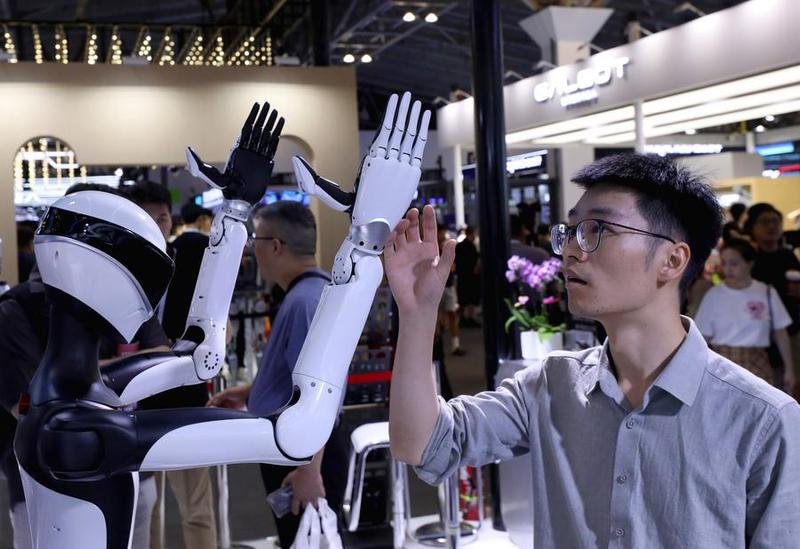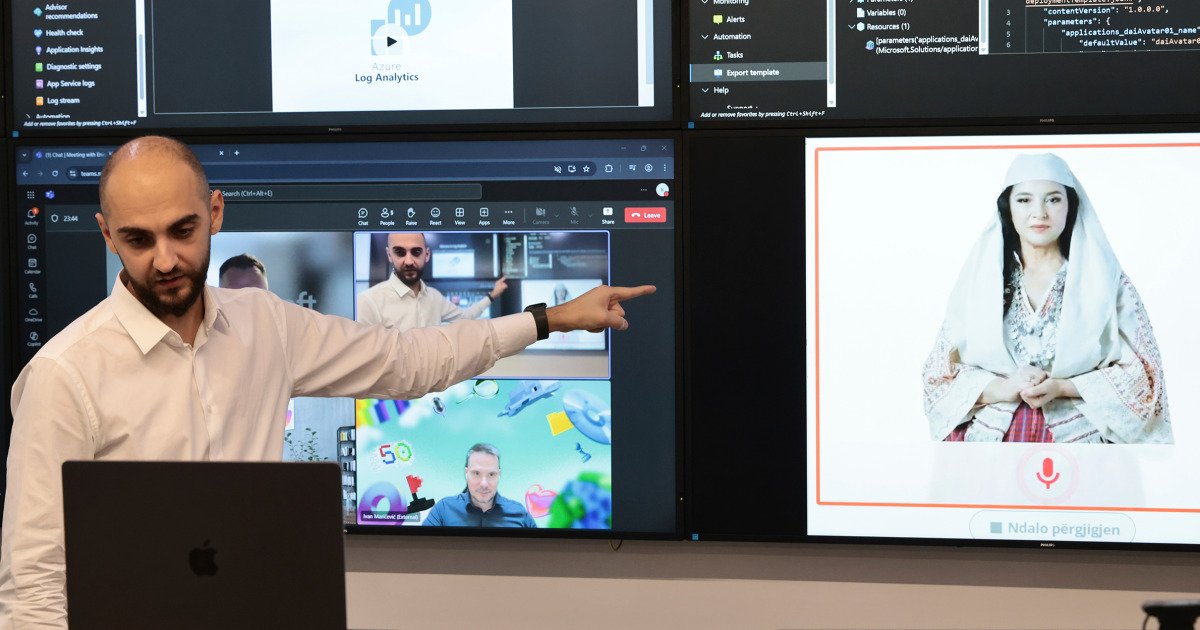AI Research
Enthusiasm Over Artificial Intelligence Boosted Nova Ltd. (NVMI) in Q2

Artificial intelligence is the greatest investment opportunity of our lifetime. The time to invest in groundbreaking AI is now, and this stock is a steal!
AI is eating the world—and the machines behind it are ravenous.
Each ChatGPT query, each model update, each robotic breakthrough consumes massive amounts of energy. In fact, AI is already pushing global power grids to the brink.
Wall Street is pouring hundreds of billions into artificial intelligence—training smarter chatbots, automating industries, and building the digital future. But there’s one urgent question few are asking:
Where will all of that energy come from?
AI is the most electricity-hungry technology ever invented. Each data center powering large language models like ChatGPT consumes as much energy as a small city. And it’s about to get worse.
Even Sam Altman, the founder of OpenAI, issued a stark warning:
“The future of AI depends on an energy breakthrough.”
Elon Musk was even more blunt:
“AI will run out of electricity by next year.”
As the world chases faster, smarter machines, a hidden crisis is emerging behind the scenes. Power grids are strained. Electricity prices are rising. Utilities are scrambling to expand capacity.
And that’s where the real opportunity lies…
One little-known company—almost entirely overlooked by most AI investors—could be the ultimate backdoor play. It’s not a chipmaker. It’s not a cloud platform. But it might be the most important AI stock in the US owns critical energy infrastructure assets positioned to feed the coming AI energy spike.
As demand from AI data centers explodes, this company is gearing up to profit from the most valuable commodity in the digital age: electricity.
The “Toll Booth” Operator of the AI Energy Boom
- It owns critical nuclear energy infrastructure assets, positioning it at the heart of America’s next-generation power strategy.
- It’s one of the only global companies capable of executing large-scale, complex EPC (engineering, procurement, and construction) projects across oil, gas, renewable fuels, and industrial infrastructure.
- It plays a pivotal role in U.S. LNG exportation—a sector about to explode under President Trump’s renewed “America First” energy doctrine.
Trump has made it clear: Europe and U.S. allies must buy American LNG.
And our company sits in the toll booth—collecting fees on every drop exported.
But that’s not all…
As Trump’s proposed tariffs push American manufacturers to bring their operations back home, this company will be first in line to rebuild, retrofit, and reengineer those facilities.
AI. Energy. Tariffs. Onshoring. This One Company Ties It All Together.
While the world is distracted by flashy AI tickers, a few smart investors are quietly scooping up shares of the one company powering it all from behind the scenes.
AI needs energy. Energy needs infrastructure.
And infrastructure needs a builder with experience, scale, and execution.
This company has its finger in every pie—and Wall Street is just starting to notice.
Wall Street is noticing this company also because it is quietly riding all of these tailwinds—without the sky-high valuation.
While most energy and utility firms are buried under mountains of debt and coughing up hefty interest payments just to appease bondholders…
This company is completely debt-free.
In fact, it’s sitting on a war chest of cash—equal to nearly one-third of its entire market cap.
It also owns a huge equity stake in another red-hot AI play, giving investors indirect exposure to multiple AI growth engines without paying a premium.
And here’s what the smart money has started whispering…
The Hedge Fund Secret That’s Starting to Leak Out
This stock is so off-the-radar, so absurdly undervalued, that some of the most secretive hedge fund managers in the world have begun pitching it at closed-door investment summits.
They’re sharing it quietly, away from the cameras, to rooms full of ultra-wealthy clients.
Why? Because excluding cash and investments, this company is trading at less than 7 times earnings.
And that’s for a business tied to:
- The AI infrastructure supercycle
- The onshoring boom driven by Trump-era tariffs
- A surge in U.S. LNG exports
- And a unique footprint in nuclear energy—the future of clean, reliable power
You simply won’t find another AI and energy stock this cheap… with this much upside.
This isn’t a hype stock. It’s not riding on hope.
It’s delivering real cash flows, owns critical infrastructure, and holds stakes in other major growth stories.
This is your chance to get in before the rockets take off!
Disruption is the New Name of the Game: Let’s face it, complacency breeds stagnation.
AI is the ultimate disruptor, and it’s shaking the foundations of traditional industries.
The companies that embrace AI will thrive, while the dinosaurs clinging to outdated methods will be left in the dust.
As an investor, you want to be on the side of the winners, and AI is the winning ticket.
The Talent Pool is Overflowing: The world’s brightest minds are flocking to AI.
From computer scientists to mathematicians, the next generation of innovators is pouring its energy into this field.
This influx of talent guarantees a constant stream of groundbreaking ideas and rapid advancements.
By investing in AI, you’re essentially backing the future.
The future is powered by artificial intelligence, and the time to invest is NOW.
Don’t be a spectator in this technological revolution.
Dive into the AI gold rush and watch your portfolio soar alongside the brightest minds of our generation.
This isn’t just about making money – it’s about being part of the future.
So, buckle up and get ready for the ride of your investment life!
Act Now and Unlock a Potential 100+% Return within 12 to 24 months.
We’re now offering month-to-month subscriptions with no commitments.
For a ridiculously low price of just $9.99 per month, you can unlock our in-depth investment research and exclusive insights – that’s less than a single fast food meal!
Here’s why this is a deal you can’t afford to pass up:
- Access to our Detailed Report on our AI, Tariffs, and Nuclear Energy Stock with 100+% potential upside within 12 to 24 months
- BONUS REPORT on our #1 AI-Robotics Stock with 10000% upside potential: Our in-depth report dives deep into our #1 AI/robotics stock’s groundbreaking technology and massive growth potential.
- One New Issue of Our Premium Readership Newsletter: You will also receive one new issue per month and at least one new stock pick per month from our monthly newsletter’s portfolio over the next 12 months. These stocks are handpicked by our research director, Dr. Inan Dogan.
- One free upcoming issue of our 70+ page Quarterly Newsletter: A value of $149
- Bonus Content: Premium access to members-only fund manager video interviews
- Ad-Free Browsing: Enjoy a month of investment research free from distracting banner and pop-up ads, allowing you to focus on uncovering the next big opportunity.
- Lifetime Price Guarantee: Your renewal rate will always remain the same as long as your subscription is active.
- 30-Day Money-Back Guarantee: If you’re not absolutely satisfied with our service, we’ll provide a full refund within 30 days, no questions asked.
Space is Limited! Only 1000 spots are available for this exclusive offer. Don’t let this chance slip away – subscribe to our Premium Readership Newsletter today and unlock the potential for a life-changing investment.
Here’s what to do next:
1. Head over to our website and subscribe to our Premium Readership Newsletter for just $9.99.
2. Enjoy a month of ad-free browsing, exclusive access to our in-depth report on the Trump tariff and nuclear energy company as well as the revolutionary AI-robotics company, and the upcoming issues of our Premium Readership Newsletter.
3. Sit back, relax, and know that you’re backed by our ironclad 30-day money-back guarantee.
Don’t miss out on this incredible opportunity! Subscribe now and take control of your AI investment future!
No worries about auto-renewals! Our 30-Day Money-Back Guarantee applies whether you’re joining us for the first time or renewing your subscription a month later!
AI Research
What is artificial intelligence’s greatest risk? – Opinion

Risk dominates current discussions on AI governance. This July, Geoffrey Hinton, a Nobel and Turing laureate, addressed the World Artificial Intelligence Conference in Shanghai. His speech bore the title he has used almost exclusively since leaving Google in 2023: “Will Digital Intelligence Replace Biological Intelligence?” He stressed, once again, that AI might soon surpass humanity and threaten our survival.
Scientists and policymakers from China, the United States, European countries and elsewhere, nodded gravely in response. Yet this apparent consensus masks a profound paradox in AI governance. Conference after conference, the world’s brightest minds have identified shared risks. They call for cooperation, sign declarations, then watch the world return to fierce competition the moment the panels end.
This paradox troubled me for years. I trust science, but if the threat is truly existential, why can’t even survival unite humanity? Only recently did I grasp a disturbing possibility: these risk warnings fail to foster international cooperation because defining AI risk has itself become a new arena for international competition.
Traditionally, technology governance follows a clear causal chain: identify specific risks, then develop governance solutions. Nuclear weapons pose stark, objective dangers: blast yield, radiation, fallout. Climate change offers measurable indicators and an increasingly solid scientific consensus. AI, by contrast, is a blank canvas. No one can definitively convince everyone whether the greatest risk is mass unemployment, algorithmic discrimination, superintelligent takeover, or something entirely different that we have not even heard of.
This uncertainty transforms AI risk assessment from scientific inquiry into strategic gamesmanship. The US emphasizes “existential risks” from “frontier models”, terminology that spotlights Silicon Valley’s advanced systems.
This framework positions American tech giants as both sources of danger and essential partners in control. Europe focuses on “ethics” and “trustworthy AI”, extending its regulatory expertise from data protection into artificial intelligence. China advocates that “AI safety is a global public good”, arguing that risk governance should not be monopolized by a few nations but serve humanity’s common interests, a narrative that challenges Western dominance while calling for multipolar governance.
Corporate actors prove equally adept at shaping risk narratives. OpenAI’s emphasis on “alignment with human goals” highlights both genuine technical challenges and the company’s particular research strengths. Anthropic promotes “constitutional AI” in domains where it claims special expertise. Other firms excel at selecting safety benchmarks that favor their approaches, while suggesting the real risks lie with competitors who fail to meet these standards. Computer scientists, philosophers, economists, each professional community shapes its own value through narrative, warning of technical catastrophe, revealing moral hazards, or predicting labor market upheaval.
The causal chain of AI safety has thus been inverted: we construct risk narratives first, then deduce technical threats; we design governance frameworks first, then define the problems requiring governance. Defining the problem creates causality. This is not epistemological failure but a new form of power, namely making your risk definition the unquestioned “scientific consensus”. For how we define “artificial general intelligence”, which applications constitute “unacceptable risk”, what counts as “responsible AI”, answers to all these questions will directly shape future technological trajectories, industrial competitive advantages, international market structures, and even the world order itself.
Does this mean AI safety cooperation is doomed to empty talk? Quite the opposite. Understanding the rules of the game enables better participation.
AI risk is constructed. For policymakers, this means advancing your agenda in international negotiations while understanding the genuine concerns and legitimate interests behind others’.
Acknowledging construction doesn’t mean denying reality, regardless of how risks are defined, solid technical research, robust contingency mechanisms, and practical safeguards remain essential. For businesses, this means considering multiple stakeholders when shaping technical standards and avoiding winner-takes-all thinking.
True competitive advantage stems from unique strengths rooted in local innovation ecosystems, not opportunistic positioning. For the public, this means developing “risk immunity”, learning to discern the interest structures and power relations behind different AI risk narratives, neither paralyzed by doomsday prophecies nor seduced by technological utopias.
International cooperation remains indispensable, but we must rethink its nature and possibilities. Rather than pursuing a unified AI risk governance framework, a consensus that is neither achievable nor necessary, we should acknowledge and manage the plurality of risk perceptions. The international community needs not one comprehensive global agreement superseding all others, but “competitive governance laboratories” where different governance models prove their worth in practice. This polycentric governance may appear loose but can achieve higher-order coordination through mutual learning and checks and balances.
We habitually view AI as another technology requiring governance, without realizing it is changing the meaning of “governance” itself. The competition to define AI risk isn’t global governance’s failure but its necessary evolution: a collective learning process for confronting the uncertainties of transformative technology.
The author is an associate professor at the Center for International Security and Strategy, Tsinghua University.
The views don’t necessarily represent those of China Daily.
If you have a specific expertise, or would like to share your thought about our stories, then send us your writings at opinion@chinadaily.com.cn, and comment@chinadaily.com.cn.
AI Research
Albania’s prime minister appoints an AI-generated ‘minister’ to tackle corruption

TIRANA, Albania — Albania’s prime minister on Friday tapped an Artificial Intelligence-generated “minister” to tackle corruption and promote transparency and innovation in his new Cabinet.
Officially named Diella — the female form of the word for sun in the Albanian language — the new AI minister is a virtual entity.
Diella will be a “member of the Cabinet who is not present physically but has been created virtually,” Prime Minister Edi Rama said in a post on Facebook.
Rama said the AI-generated bot would help ensure that “public tenders will be 100% free of corruption” and will help the government work faster and with full transparency.
Diella uses AI’s up-to-date models and techniques to guarantee accuracy in offering the duties it is charged with, according to Albania’s National Agency for Information Society’s website.
Diella, depicted as a figure in a traditional Albanian folk costume, was created earlier this year, in cooperation with Microsoft, as a virtual assistant on the e-Albania public service platform, where she has helped users navigate the site and get access to about 1 million digital inquiries and documents.
Rama’s Socialist Party secured a fourth consecutive term after winning 83 of the 140 Assembly seats in the May 11 parliamentary elections. The party can govern alone and pass most legislation, but it needs a two-thirds majority, or 93 seats, to change the Constitution.
The Socialists have said it can deliver European Union membership for Albania in five years, with negotiations concluding by 2027. The pledge has been met with skepticism by the Democrats, who contend Albania is far from prepared.
The Western Balkan country opened full negotiations to join the EU a year ago. The new government also faces the challenges of fighting organized crime and corruption, which has remained a top issue in Albania since the fall of the communist regime in 1990.
Diella also will help local authorities to speed up and adapt to the bloc’s working trend.
Albanian President Bajram Begaj has mandated Rama with the formation of the new government. Analysts say that gives the prime minister authority “for the creation and functioning” of AI-generated Diella.
Asked by journalists whether that violates the constitution, Begaj stopped short on Friday of describing Diella’s role as a ministerial post.
The conservative opposition Democratic Party-led coalition, headed by former prime minister and president Sali Berisha, won 50 seats. The party has not accepted the official election results, claiming irregularities, but its members participated in the new parliament’s inaugural session. The remaining seats went to four smaller parties.
Lawmakers will vote on the new Cabinet but it was unclear whether Rama will ask for a vote on Diella’s virtual post. Legal experts say more work may be needed to establish Diella’s official status.
The Democrats’ parliamentary group leader Gazmend Bardhi said he considered Diella’s ministerial status unconstitutional.
“Prime minister’s buffoonery cannot be turned into legal acts of the Albanian state,” Bardhi posted on Facebook.
Parliament began the process on Friday to swear in the new lawmakers, who will later elect a new speaker and deputies and formally present Rama’s new Cabinet.
AI Research
AI fuels false claims after Charlie Kirk’s death, CBS News analysis reveals

False claims, conspiracy theories and posts naming people with no connection to the incident spread rapidly across social media in the aftermath of conservative activist Charlie Kirk’s killing on Wednesday, some amplified and fueled by AI tools.
CBS News identified 10 posts by Grok, X’s AI chatbot, that misidentified the suspect before his identity, now known to be southern Utah resident Tyler Robinson, was released. Grok eventually generated a response saying it had incorrectly identified the suspect, but by then, posts featuring the wrong person’s face and name were already circulating across X.
The chatbot also generated altered “enhancements” of photos released by the FBI. One such photo was reposted by the Washington County Sheriff’s Office in Utah, which later posted an update saying, “this appears to be an AI enhanced photo” that distorted the clothing and facial features.
One AI-enhanced image portrayed a man appearing much older than Robinson, who is 22. An AI-generated video that smoothed out the suspect’s features and jumbled his shirt design was posted by an X user with more than 2 million followers and was reposted thousands of times.
On Friday morning, after Utah Gov. Spencer Cox announced that the suspect in custody was Robinson, Grok’s replies to X users’ inquiries about him were contradictory. One Grok post said Robinson was a registered Republican, while others reported he was a nonpartisan voter. Voter registration records indicate Robinson is not affiliated with a political party.
CBS News also identified a dozen instances where Grok said that Kirk was alive the day following his death. Other Grok responses gave a false assassination date, labeled the FBI’s reward offer a “hoax” and said that reports about Kirk’s death “remain conflicting” even after his death had been confirmed.
Most generative AI tools produce results based on probability, which can make it challenging for them to provide accurate information in real time as events unfold, S. Shyam Sundar, a professor at Penn State University and the director of the university’s Center for Socially Responsible Artificial Intelligence, told CBS News.
“They look at what is the most likely next word or next passage,” Sundar said. “It’s not based on fact checking. It’s not based on any kind of reportage on the scene. It’s more based on the likelihood of this event occurring, and if there’s enough out there that might question his death, it might pick up on some of that.”
X did not respond to a request for comment about the false information Grok was posting.
Meanwhile, the AI-powered search engine Perplexity’s X bot described the shooting as a “hypothetical scenario” in a since-deleted post, and suggested a White House statement on Kirk’s death was fabricated.
Perplexity’s spokesperson told CBS News that “accurate AI is the core technology we are building and central to the experience in all of our products,” but that “Perplexity never claims to be 100% accurate.”
Another spokesperson added the X bot is not up to date with improvements the company has made to its technology, and the company has since removed the bot from X.
Google’s AI Overview, a summary of search results that sometimes appears at the top of searches, also provided inaccurate information. The AI Overview for a search late Thursday evening for Hunter Kozak, the last person to ask Kirk a question before he was killed, incorrectly identified him as the person of interest the FBI was looking for. By Friday morning, the false information no longer appeared for the same search.
“The vast majority of the queries seeking information on this topic return high quality and accurate responses,” a Google spokesperson told CBS News. “Given the rapidly evolving nature of this news, it’s possible that our systems misinterpreted web content or missed some context, as all Search features can do given the scale of the open web.”
Sundar told CBS News that people tend to perceive AI as being less biased or more reliable than someone online who they don’t know.
“We don’t think of machines as being partisan or bias or wanting to sow seeds of dissent,” Sundar said. “If it’s just a social media friend or some somebody on the contact list that’s sent something on your feed with unknown pedigree … chances are people trust the machine more than they do the random human.”
Misinformation may also be coming from foreign sources, according to Cox, Utah’s governor, who said in a press briefing on Thursday that foreign adversaries including Russia and China have bots that “are trying to instill disinformation and encourage violence.” Cox urged listeners to spend less time on social media.
“I would encourage you to ignore those and turn off those streams, and to spend a little more time with our families,” he said.
-

 Business2 weeks ago
Business2 weeks agoThe Guardian view on Trump and the Fed: independence is no substitute for accountability | Editorial
-
Tools & Platforms1 month ago
Building Trust in Military AI Starts with Opening the Black Box – War on the Rocks
-

 Ethics & Policy2 months ago
Ethics & Policy2 months agoSDAIA Supports Saudi Arabia’s Leadership in Shaping Global AI Ethics, Policy, and Research – وكالة الأنباء السعودية
-

 Events & Conferences4 months ago
Events & Conferences4 months agoJourney to 1000 models: Scaling Instagram’s recommendation system
-

 Jobs & Careers2 months ago
Jobs & Careers2 months agoMumbai-based Perplexity Alternative Has 60k+ Users Without Funding
-

 Podcasts & Talks2 months ago
Podcasts & Talks2 months agoHappy 4th of July! 🎆 Made with Veo 3 in Gemini
-

 Education2 months ago
Education2 months agoVEX Robotics launches AI-powered classroom robotics system
-

 Education2 months ago
Education2 months agoMacron says UK and France have duty to tackle illegal migration ‘with humanity, solidarity and firmness’ – UK politics live | Politics
-

 Funding & Business2 months ago
Funding & Business2 months agoKayak and Expedia race to build AI travel agents that turn social posts into itineraries
-

 Podcasts & Talks2 months ago
Podcasts & Talks2 months agoOpenAI 🤝 @teamganassi

